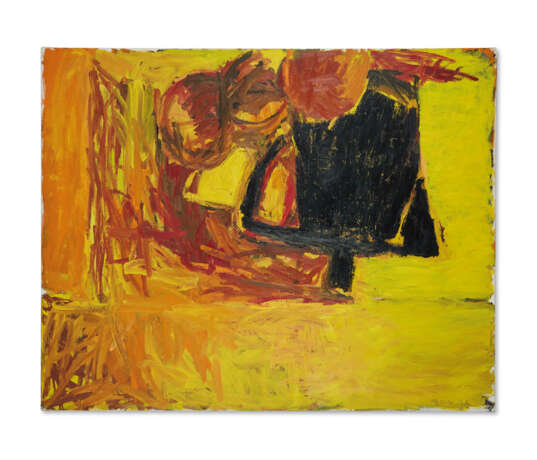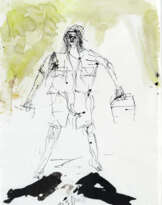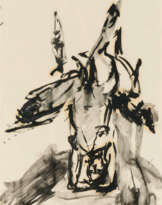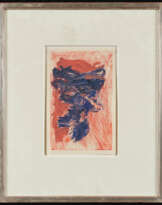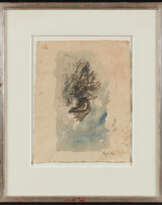ID 832065
Лот 27 | Georg Baselitz (né en 1938)
Оценочная стоимость
€ 600 000 – 800 000
Schwarze Kaffeekanne
signé des initiales, daté et inscrit '14 II. 82 G.B.' (en bas à droite); signé et daté de nouveau et inscrit 'Schwarze Kaffeekanne 14.II.82 G. Baselitz' (au revers)
huile sur toile
200 x 250 cm.
Peint en 1982
signed with the initials, dated and inscribed '14 II. 82 G.B.' (lower right); signed and dated again, inscribed 'Schwarze Kaffeekanne 14.II.82 G. Baselitz' (on the reverse)
oil on canvas
76 3/4 x 98 3/8 in.
Painted in 1982
Provenance
Michael Werner, Cologne.
Wolfgang Hahn (acquis auprès de celle-ci).
Puis par descendance au propriétaire actuel.
Special notice
Artist's Resale Right ("droit de Suite").
If the Artist's Resale Right Regulations 2006 apply to this lot, the buyer also agrees to pay us an amount equal to the resale royalty provided for in those Regulations, and we undertake to the buyer to pay such amount to the artist's collection agent.
This item will be transferred to an offsite warehouse after the sale. Please refer to department for information about storage charges and collection
details.
Post lot text
« À partir de 1981, Baselitz intensifie nettement l'expressivité de son travail. Il ne subordonne plus le motif à un dynamisme ancré dans des impulsions gestuelles et conduisant à un mépris plus ou moins radical des critères de représentation, mais poursuit un processus de concentration. Celui-ci est parfois réalisé de manière extrêmement peu conventionnelle. Baselitz simplifie ses représentations, et les figures deviennent plus volumineuses, plus succinctes dans leurs proportions et leur aspect général, on pourrait même dire plus primitives ». - Andreas Franzke (dans Andreas Franzke, Georg Baselitz, Prestel, 1989, p.156)
"From 1981 on, Baselitz clearly intensifies the expressivity of his work. He no longer subordinates the motif to dynamics rooted
in gestural impulses and leading to more or less radical disregard of representational criteria, but pursues a process of concentration. This is sometimes realized in an extremely unconventional way. Baselitz simplifies his representations, and the figures become bulkier, more succinct in their proportions and general aspect, one might even say more primitive.” - Andreas Franzke (in Andreas Franzke, Georg Baselitz, Prestel, 1989, p.156)
« La hiérarchie où le ciel est en haut et le sol en bas n’est de toute façon qu’une convention à laquelle nous nous sommes habitués, mais à laquelle nous ne sommes pas obligés de croire ». - Georg Baselitz
Imprégné d’un empâtement vibrant de jaune, de rouge et d’orange, Schwarze Kaffeekanne (Cafetière noire) (1982) est un exemple monumental des inversions picturales de Georg Baselitz. Une forme sombre et anguleuse est visible vers le bord supérieur de la peinture, rejointe par trois sphères grossièrement ombragées et une touche de nuances ardentes, apparemment abstraites. Ce n’est qu’après un examen approfondi que le spectateur peut identifier le récipient noir en question et une poignée de fruits - un ensemble familier dans les natures mortes de la Renaissance à Cézanne - radicalement renversé. Ces formes conventionnelles sont devenues abstraites et étrangères, oscillant entre des objets représentés et un arrangement de couleurs et de formes pures. Par ses deux mètres de haut et ses deux mètres et demi de large, la toile est d’autant plus impressionnante. En vacillant et en perdant sa lisibilité, le pot à café noir semble même prendre une présence curieusement anthropomorphique, rappelant la silhouette d’un homme aux bras écartés, un thème figuratif commun aux œuvres de Baselitz de cette époque. Plutôt que d’inverser un tableau fini, l’artiste commence et termine l’œuvre dans ce format, travaillant dans une nouvelle logique de composition qui aboutit à un choc visuel extraordinaire. Schwarze Kaffeekanne appartenait auparavant à Wolfgang Hahn, chef des départements de conservation du musée Wallraf Richartz et du musée Ludwig de Cologne, et collectionneur pionnier du Nouveau Réalisme, de Fluxus, du Pop Art et de l’art conceptuel.
Baselitz commence à utiliser sa technique radicale de l’inversion en 1969 comme moyen de « vider » ses tableaux de la tradition et de la signification qui y est associée. Ces peintures convulsives, qui illustrent un découplage du support et du sujet, lui permettent de réconcilier son propre statut de peintre dans la société turbulente et incertaine de l’Allemagne d’après-guerre. Après son emménagement en 1975 dans un vaste château à Derneburg, où il vivra pendant les trois décennies suivantes, Baselitz commence à travailler à une échelle de plus en plus ambitieuse et avec un souci accru de la puissance formelle de ses compositions, délaissant les motifs teutoniques chargés au profit d’une dynamique picturale vigoureuse. Il commence également à explorer la sculpture à grande échelle : cette orientation expansive trouve un écho dans le traitement emphatique et expressif de la lumière et de l’obscurité de cette œuvre, dont les pigments semblent presque taillés dans la surface. Son intérêt pour la structure s’accentue davantage après 1981, lorsqu’il commence à travailler dans un studio près d’Arezzo, en Italie, et qu’il étudie les fresques de Piero della Francesca, de la taille d’une murale et à la composition serrée.
Mais le plus pertinent est peut-être que, comme de nombreuses peintures importantes de cette période, Schwarze Kaffeekanne reflète l’admiration de Baselitz pour l’expressionnisme abstrait américain. Il assiste à deux grandes expositions européennes du mouvement lors de ses études à Berlin à la fin des années 1950, et est impressionné par la liberté, la puissance et l’échelle dramatique des œuvres d’artistes tels que Pollock, de Kooning, Motherwell, Kline et Rothko. Contrairement à l’art national-socialiste et communiste fade et narratif avec lequel il a grandi, ces peintures s’attaquent à la peinture, plutôt que d’illustrer des histoires ou de délivrer des messages. Si ces abstractions énergiques inspirent Baselitz par leur esprit libéré et existentiel, ses premières réalisations sont résolument figuratives. Ce n’est qu’à la fin des années 1970 et au début des années 1980 qu’il s’attelle formellement aux grandes compositions « all-over » de l’école de New York dans ses peintures. Dans ces œuvres, Baselitz élargit également son champ d’action de la catharsis allemande au déracinement et à la fracture de l’histoire de l’art dans son ensemble, en inversant les traditions figuratives éprouvées du portrait au paysage, au nu couché et, comme dans la présente œuvre, à la nature morte. Célébrant l’immédiateté du travail au pinceau et la tactilité du pigment, Schwarze Kaffeekanne brise les conventions pour ouvrir un nouveau territoire à la peinture elle-même. L’œuvre est une vision ludique et vivante du bouleversement, faisant renaître son médium par une secousse corporelle électrique.
"The hierarchy where the sky is at the top and the ground down below is in any case only an agreement, one that we have all got used to, but one that we absolutely do not have to believe in." - Georg Baselitz
Aglow in a vibrant impasto of yellow, red and orange, Schwarze Kaffeekanne (Black Coffee-pot) (1982) is a monumental example of Georg Baselitz’s pictorial inversions. A dark, angular shape is visible towards the painting’s upper edge, joined by three roughly-shadowed spheres and a thatch of fiery-hued, seemingly abstract brushwork. Only on prolonged inspection can the viewer identify the titular black vessel and a handful of fruit—a grouping familiar in still-lifes from the Renaissance to Cézanne—turned radically upside-down. These conventional forms have become abstracted and alien, oscillating between depicted objects and an arrangement of pure colour and shape. At two metres high and two-and-a-half metres across, the canvas’s vast size compounds their startling impact. Flickering in and out of legibility, the black coffee-pot even seems to take on a curiously anthropomorphic presence, echoing the silhouette of a man with his arms out by his sides—a common figural theme in works by Baselitz from this time. Rather than inverting a finished painting, the artist begins and ends the work in this format, working in a new compositional logic that carries an extraordinary visual shock. Schwarze Kaffeekanne was previously owned by Wolfgang Hahn: head of the conservation departments at the Wallraf Richartz Museum and the Museum Ludwig, Cologne, and a pioneering collector of Nouveau Réaliste, Fluxus, Pop and Conceptual art.
Baselitz had started using his radical upside-down device in 1969 as a way of ‘emptying’ his pictures of tradition and associated meaning. Through these convulsive paintings, which pictured a decoupling of medium and subject matter, he was able to reconcile his own status as a painter in Germany’s turbulent and uncertain post-war society. Following his 1975 move to a vast castle in Derneburg, where he would live for the next three decades, Baselitz began to work at an increasingly ambitious scale and with a heightened concern for his compositions’ formal power, de-emphasising loaded Teutonic motifs in favour of vigorous painterly dynamics. He also started to explore large-scale sculpture: an expansive direction echoed in the present work’s emphatic, expressive handling of light and dark, with its pigments appearing almost hacked into the surface. His structural focus was heightened further after 1981, when he started using a studio near Arezzo, Italy, and studied the tightly composed, mural-sized frescoes of Piero della Francesca.
Perhaps most pertinently, however, like many important paintings of this period, Schwarze Kaffeekanne reflects Baselitz’s admiration for American Abstract Expressionism. He had witnessed two major early European exhibitions of the movement while studying in Berlin in the late 1950s, and was impressed by the freedom, power and dramatic scale of the works he saw by artists such as Pollock, de Kooning, Motherwell, Kline, and Rothko. Unlike the blandly narrative National Socialist and Communist art that he had grown up with, these were paintings that tackled painting, rather than illustrating stories or delivering messages. While these forceful abstractions inspired Baselitz with their liberated, existential spirit, his own early achievements were decidedly figurative. It was not until the late 1970s and early 1980s that he grappled formally with the grand ‘all-over’ compositions of the New York School in his paintings. In these works Baselitz also widened his remit from Germany’s catharsis to the uprooting and fracture of art history at large, inverting timeworn figurative traditions from portraiture to the landscape, the reclining nude, and—as in the present work—the still-life. Foregrounding the immediacy of brushwork and the tactility of pigment, Schwarze Kaffeekanne breaks down convention to open new territory for painting itself. The work is a playful, vivid vision of upheaval, rebirthing its medium with an electric bodily jolt.
| Автор: | Георг Базелиц (1938) |
|---|---|
| Художественный стиль: | Современное искусство |
| Место происхождения: | Западная Европа, Германия, Европа |
| Категория аукционного дома: | Картины |
| Автор: | Георг Базелиц (1938) |
|---|---|
| Художественный стиль: | Современное искусство |
| Место происхождения: | Западная Европа, Германия, Европа |
| Категория аукционного дома: | Картины |
| Адрес торгов |
CHRISTIE'S 8 King Street, St. James's SW1Y 6QT London Великобритания | |
|---|---|---|
| Предосмотр |
| |
| Телефон | +44 (0)20 7839 9060 | |
| Комиссия | see on Website | |
| Условия использования | Условия использования |
